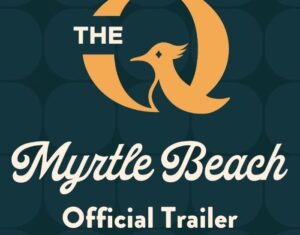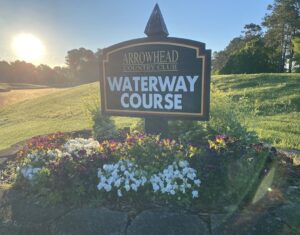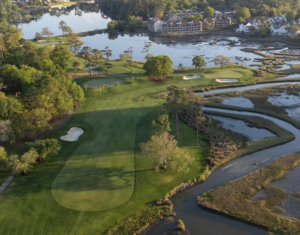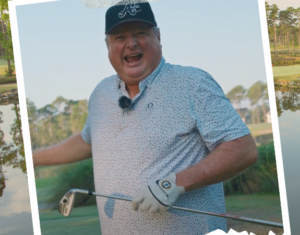Charlie Rymer Visits Whispering Pines Golf Club
Built in 1962, has been a key part of Myrtle Beach for some time now. Watch as Charlie Rymer and Chip Smith of Atlantic Golf Management, talk about the history of this golf course.
Charlie Rymer:
I’m hanging out with Chip Smith, with Atlantic Golf Management. We’re at Whispering Pines. This is your facility. Chip, I’ve got to tell you. On approach, coming in to Myrtle Beach International, which is just right over here, this golf course looks absolutely spectacular from there. We’re going to get out on it here in a minute.
I know this is a project you’re very proud of. Tell me a little bit about the history of this golf course.
Chip Smith:
Thank you, Charlie. This course was built in the ’60s by members of the (Myrtle Beach) Air Force Base, and actual people that were in the Air Force. They built it, designed the holes and all. It was a nine-hole facility with two sets of tees. I remember playing it as a young man in that regard.
Then the course was changed to an 18-hole facility in the late ’80s. The air base closed in 1991, and the course kind of sat in limbo for a lot of years. Then the City of Myrtle Beach got involved. Then they decided it might be best to close the course, about five years ago. That’s when the former mayor, John Rhodes, got us involved.
He asked me to go play golf one day. I thought we were going to The Dunes Club, and we came to Whispering Pines. I came kicking and screaming, and then realized what a good layout it was. Since it was 18 holes.
We got involved and did a complete turnaround here with the course. It was not very good, not anything to be proud of. Today, I think myself and the City of Myrtle Beach are very proud of what’s happened here, condition-wise. It shows with the rounds we do, and the comments we get.
Charlie Rymer:
I noticed right behind us, there are some plaques here and there. These plaques are in different places on the golf course as well, too. Tell me a little bit about how that pays tribute to the history here.
Chip Smith:
After the base closed in ’91, the course just floundered a little bit. One of the things we thought was important was the historical significance of the golf course. We got with the Myrtle Beach Air Force Base Redevelopment Authority and put together a program. What you see here and on every tee box, there are 30 wing commanders in the history of the Air Force Base. We have one on each of the 18 holes, and then 12 more around the clubhouse, with a little bio on those wing commanders and their service they gave to our country.
Then we also, there were four squadrons here over the history. Our four tees are named after those four squadrons, you’ll see on the card. We tried to show our appreciation and honor back to those that served.
Charlie Rymer:
I know that folks who come to Myrtle Beach and come here to play golf, a lot of times they’re coming from bad weather in the wintertime. Or they might not have been able to play golf in a few weeks. It’s pretty amazing how close we are to baggage claim at the airport over here. I bet you’ve seen some interesting things, with folks getting right off the plane and heading over here to play golf over the years.
Chip Smith:
We do. It’s pretty funny. You’ll see people every now and then pulling a golf carrier bag with one hand, and their luggage with the other. They’ll walk straight from baggage claim over here. We store their luggage. They may have a 3:00 check-in time, and they flew in from Boston at 8 a.m. So they’ll come play a round of golf and have lunch. Then there’s a little time to Uber on to the hotel.
But that keeps them from wasting the day when they get here. Like you said, they’ve been locked up all winter in the cold weather. They land, and they can see this. They’re here, in five minutes time they’ve walked over here, and on the first tee. That’s always fun to see, and they do it on the way out some days.
Charlie Rymer:
Yeah. Well it sure looks good from the back porch here. Let’s head out and play a few holes. You ready?
Chip Smith:
That sounds great.
Charlie Rymer:
All right.
Charlie Rymer:
So Chip, we’re on 17 tee. Beautiful par three over the pond. But I’ve got to tell you, my eye is drawn towards that airport right there. I’m just thinking about these people getting off the plane and coming over here, and being able to get on this golf course so quickly. A really unique facility you have here.
Chip Smith:
Thank you. You know, with the elevation you literally can see the gate, from where they walk out to get their car or the cab from here. We are right on top of the airport. We do get a lot of that. I think we’re a good first impression for people coming to Myrtle Beach.
Charlie Rymer:
Absolutely. Golf course is in perfect shape. Will you lead us off here? We’ve got 165 yards, a little downwind. Helping from the right.
Did you make it? Go in!
Chip Smith:
We’ll see.
Charlie Rymer:
Good shot right there.
Chip Smith:
Thank you. Thank you.
Charlie Rymer:
All right. I don’t know if I can beat that or not, but I’ll try. Get down, baby. Middle of the green.
Chip Smith:
All right.
Charlie Rymer:
All right.
Chip Smith:
We’ve got two putts, it’s a birdie, so that’s good.
Charlie Rymer:
Let’s head up there.
Chip Smith:
All right.
Charlie Rymer:
We can stop by the food court at the airport on the way if you want to.
Chip Smith:
That’s a good idea.
Charlie Rymer:
All right, let’s see what we’ve got here. Get that flag out of there.
Chip Smith:
Yeah, that’s got it.
Charlie Rymer:
Oh. Thought I made that one.
Chip Smith:
Yeah, I did, too. That was a perfect line.
Charlie Rymer:
All right, let’s see you make that birdie. No, you did it to me!
Chip Smith:
Yes, I did.
Charlie Rymer:
That’s too much local knowledge there!
Chip Smith:
It’s just a two. That’s just a two.
Charlie Rymer:
Good putt.
Chip Smith:
Thank you.



